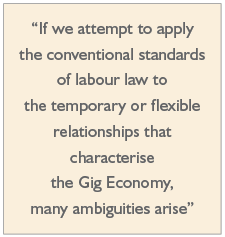 By Cho,Hyun-Jun, Lee International
By Cho,Hyun-Jun, Lee International
Labour law, as it is traditionally understood, modifies conventional contract law to protect workers by recognising the difference in power between the employer and the employee, as well as the unique characteristics of labour contracts. In that sense, labour law presupposes a dichotomy between the employer and the employee. However, with the rise of the so-called Gig Economy, we see an increasing number of grey areas where that dichotomy cannot easily be applied.
Although each nation’s labour laws may contain somewhat different details, whether a person is considered an employee is essentially determined by what may be termed subordinate labour relations. In a traditional relationship in which the employee performs the designated work at a time and place specified by the employer, the determination is fairly straightforward. But if we attempt to apply the conventional standards of labour law to the temporary or flexible relationships that characterise the Gig Economy, many ambiguities arise.
Recently, the California Supreme Court adopted the “ABC test” as a tool to determine the legal nature of workers in Dynamex Operations West, Inc v. Superior Court of Los Angeles County, a class action involving delivery drivers who were reclassified as independent contractors by their employer. Under the ABC test, a person is assumed to be a worker unless: A) the worker is free from the employer’s control or direction in performing the work; B) the work takes place outside the usual course of the business of the company and off the site of the business; and C) customarily, the worker is engaged in an independent trade, occupation, profession or business. The above ruling is seen as a ground-breaking decision more favourable to workers than earlier laws. Observers are closely following whether the same legal principle will affect wage lawsuits filed by Uber drivers both in the US and the UK.
 In Korea, as a detailed criteria to determine whether there exists an employment relationship between a worker and an employer, the Supreme Court ruled in 1994 that a number of different factors should be reviewed, focusing on substance rather than form, including (i) whether the person is governed by the rules of employment or other service (personnel) regulations; (ii) whether the person, while at work, is subject to specific and individual supervision or instructions by the employer; (iii) whether there exists any base or fixed salary given to the person in exchange for the work he/she has provided; (iv) whether the person who works is covered by employment insurance and health insurance; or (v) whether taxes are withheld by the employer on wage income. In 2006, the court instructed that those factors which an employer can control and may use to create the appearance that a worker is not an employee, such as by not withholding taxes or by not paying the worker’s four major social insurances, should be considered only secondarily as they are subject to manipulation by an employer. The stance of the Supreme Court reflects the increasingly flexible forms of employment that have been evolving and may be seen as an emphasis on substantiality in determining whether the person is an employee or an independent contractor.
In Korea, as a detailed criteria to determine whether there exists an employment relationship between a worker and an employer, the Supreme Court ruled in 1994 that a number of different factors should be reviewed, focusing on substance rather than form, including (i) whether the person is governed by the rules of employment or other service (personnel) regulations; (ii) whether the person, while at work, is subject to specific and individual supervision or instructions by the employer; (iii) whether there exists any base or fixed salary given to the person in exchange for the work he/she has provided; (iv) whether the person who works is covered by employment insurance and health insurance; or (v) whether taxes are withheld by the employer on wage income. In 2006, the court instructed that those factors which an employer can control and may use to create the appearance that a worker is not an employee, such as by not withholding taxes or by not paying the worker’s four major social insurances, should be considered only secondarily as they are subject to manipulation by an employer. The stance of the Supreme Court reflects the increasingly flexible forms of employment that have been evolving and may be seen as an emphasis on substantiality in determining whether the person is an employee or an independent contractor.
The courts may not be the best vehicle for dealing with the issues raised by the gig economy. A more comprehensive solution may require the enactment of new labour laws that strike a proper balance between the workers and the hiring companies
In Germany, such changes in technology and industrial structure are recognised in the concepts of Industry 4.0 (Industrie 4.0) and Work 4.0 (Arbeit 4.0), introduced by the Federal Ministry of Labour and Social Affairs as a framework for discussion of labour relations as a whole. The Ministry of Health, Labour and Welfare of Japan has also published a report titled 2035: The Way of Working in the Future in 2016, which discusses how to refine labour laws and labour policies to recognise the evolving way that work will be performed, especially work done with fewer time and space constraints. Korea’s Ministry of Employment and Labour is also continuing to discuss related matters.
The question of how to resolve these issues is becoming increasingly difficult as a result of the changes in the industrial structure brought about by the gig economy. However, until such issues are resolved in a new legal framework, the criteria that courts have used to date are likely to continue being applied, despite the difficulty. Both employers and workers should pay attention to these issues as they define their relations to avoid, as much as possible, unwelcome surprises in the future.

T: 82 2 2262 6288
F: 82 2 2279 5020


